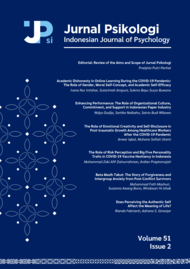Pengaruh Adaptasi Waktu Administrasi yang disebabkan Penggunaan Lembar Jawaban Komputer terhadap Hasil CFIT 3 A dan 3 B
Ridwan Saptoto(1*)
(1) Scopus ID: 57188966935, Fakultas Psikologi UGM.
(*) Corresponding Author
Abstract
Abstrak.Hasil penelitian sebelumnya menunjukkan adanya perbedaan tingkat inteligensi yang disebabkan oleh perbedaan metode memberikan jawaban. Penelitian ini bertujuan melakukan adaptasi terhadap tes yang menggunakan lembar jawaban komputer. Adaptasi waktu dilakukan dengan membandingkan waktu yang dibutuhkan untuk memberikan jawaban dengan cara menyilang dan menghitamkan alternatif jawaban menggunakan pensil 2B. Metode eksperimen dengan desain dua kelompok independen dipilih dalam penelitian ini. Analisis data menunjukkan tidak terdapat perbedaan skor mentah antara kelompok kontrol dan kelompok eksperimen pada CFIT 3A (t = 1,045, p > 0,05), CFIT 3B (t = 0,368, p > 0,05), serta CFIT 3A dan 3B (t = 0,791, p > 0,05). Analisis data juga menemukan tidak terdapat perbedaan tingkat inteligensi antara kedua kelompok pada CFIT 3A (t = 1,063, p > 0,05), CFIT 3B (t = 0,470, p > 0,05), serta CFIT 3A dan 3B (t = 0,771, p > 0,05). Adaptasi waktu administrasi tidak mengubah hasil tes inteligensi.
Keywords
Full Text:
PDFReferences
Anastasi, A. & Urbina, U. (2007). Tes psikologi (terjemahan). Jakarta: PT. Indeks.
Azwar, S. (2009). Reliabilitas dan validitas. Yogyakarta: Pustaka Pelajar.
Azwar, S. (2010). Pengantar psikologi inteligensi. Yogyakarta: Pustaka Pelajar.
Boyle, S. (1984). The effect of variations in answer-sheet format on aptitude test performance. Journal of Occupational Psychology, 57, 323-326.
Brothen, T. (2012). Time limits on tests: Updating the 1-minute rule. Teaching of Psychology, 39(4), 288-292.
Cattell, R. B. (1949). Culture fair intelligence test, scale 1.Champaign, Illinois: Institute of Personality and Ability.
Cattell, R. B. (1971). Abilities: Their structure growth and action. Boston: Houghton Mifflin.
Cattell, R. B.& Cattell, A.K.S. (1973). Culture Fair Intelligence Tests (CFIT). San Diego, CA: Educational and Industrial Testing Service (EdITS).
Choe, E. M., Kern, J. L. & Chang, H. (2017). Optimizing the use of response times for item selection in computerized adaptive testing. Journal of Educational and Behavioral Statistics, 20(10), 1-24.
Fisteus, J.A., Pardo, A. & Garcia, N.F. (2013). Grading multiple choice exams with low-cost and portable computer-vision techniques. Journal of Science, Education, and Technology, 22, 560-571.
Goldstein, G. & Hersen, M. (2000). Handbook of psychological assessment. Oxford: Pergamon Press.
Gregorie, J. & Hambleton, R. K. (2009). Advances in test adaptation research: A special issue. International Journal of Testing, 9, 75–77.
Hambleton, R. K., Merenda, P. F. & Spielberger, C. D. (2005). Adapting educational and psychological tests for cross-cultural assessment. Hillsdale, NJ: Erlbaum.
International Test Commission. (2017). The ITC guidelines for translating and adapting tests(second edition). [www.InTestCom.org]
Kumar, D. D. & Helgeson, S. L. (1995). Trends in computer applications in science assessment. Journal of Science, Education, and Technology, 4(1), 29-36.
Miller, I. (1965). A note on the evaluation of a new answer form. Journal of Applied Psychology, 49, 199-201.
Myers, A. & Hansen, C. H. (2002). Experimental psychology. California: Wadsworth Group.
Saptoto, R. (2012). Perbedaan waktu pemberian jawaban dan hasil tes inteligensi ditinjau dari perbedaan lembar jawaban. Jurnal Psikologi, 39(2), 222-232. doi: 10.22146/jpsi.6988
Sie, H., Finkelman, M. D., Riley, B. & Smits, N. (2015). Utilizing response times in computerized classification testing. Applied Psychology Measurement, 39(5), 389-405.
SMR Indonesia. (2012, 24 Februari). Deskripsi singkat SMR. Diunduh 24 Februari 2012, dari SMR Indonesia Website: smrindonesia.com/index.php?option=com_content&task=viewed&id=45<emid=146.
Article Metrics
Refbacks
- There are currently no refbacks.
Copyright (c) 2018 Jurnal Psikologi

This work is licensed under a Creative Commons Attribution-ShareAlike 4.0 International License.
Recent Issues
 |  |  |  | ||||
| Vol 51 Issue 2 (2024) Page 120-230 | Vol 51 Issue 1 (2024) Page 1-119 | Vol 50 Issue 3 (2023) Page 219-332 | Vol 50 Issue 2 (2023) Page 125-218 |
| Published by Faculty of Psychology, Universitas Gadjah Mada, Indonesia Building D-6th, Floor No. D-606. Jl. Sosio Humaniora No. 1, Bulaksumur Yogyakarta, 55281 Email: jurnalpsikologi@ugm.ac.id Phone/whatsApp: +6281125210175 |











